Ethical Leadership: Tesla's Culture, Strategy, and Reflection Report
VerifiedAdded on 2023/01/11
|17
|6148
|28
Report
AI Summary
This report provides a comprehensive analysis of ethical leadership, focusing on Tesla as a case study. It begins with a reflective report on the author's understanding of ethical leadership, emphasizing the importance of values, morals, and civility. The report then delves into a literature review, exploring definitions of ethical leadership, ethical dilemmas, and relevant theories like utilitarian ethics and stakeholder theory. The analysis further examines Tesla's organizational culture, structure, and leadership strategies, including the challenges and the role of CSR. The report highlights the importance of integrating ethics into daily business activities, managing conflicts, and addressing human rights concerns. It also discusses the influence of cultural backgrounds on leadership styles and the significance of ethical decision-making. The conclusion synthesizes the key findings and reinforces the importance of ethical leadership in business success. The report also includes references to support the arguments and findings discussed throughout the report.
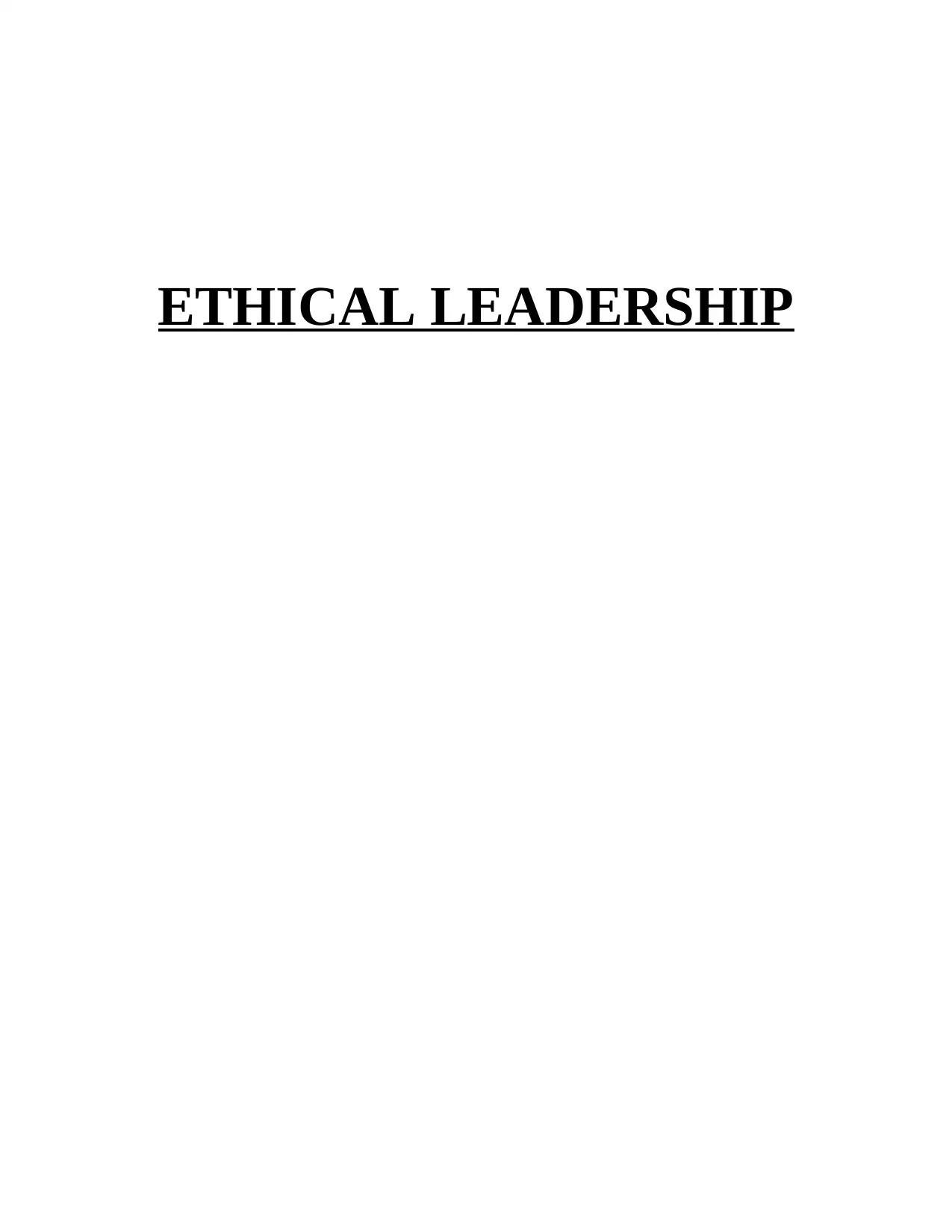
ETHICAL LEADERSHIP
Paraphrase This Document
Need a fresh take? Get an instant paraphrase of this document with our AI Paraphraser
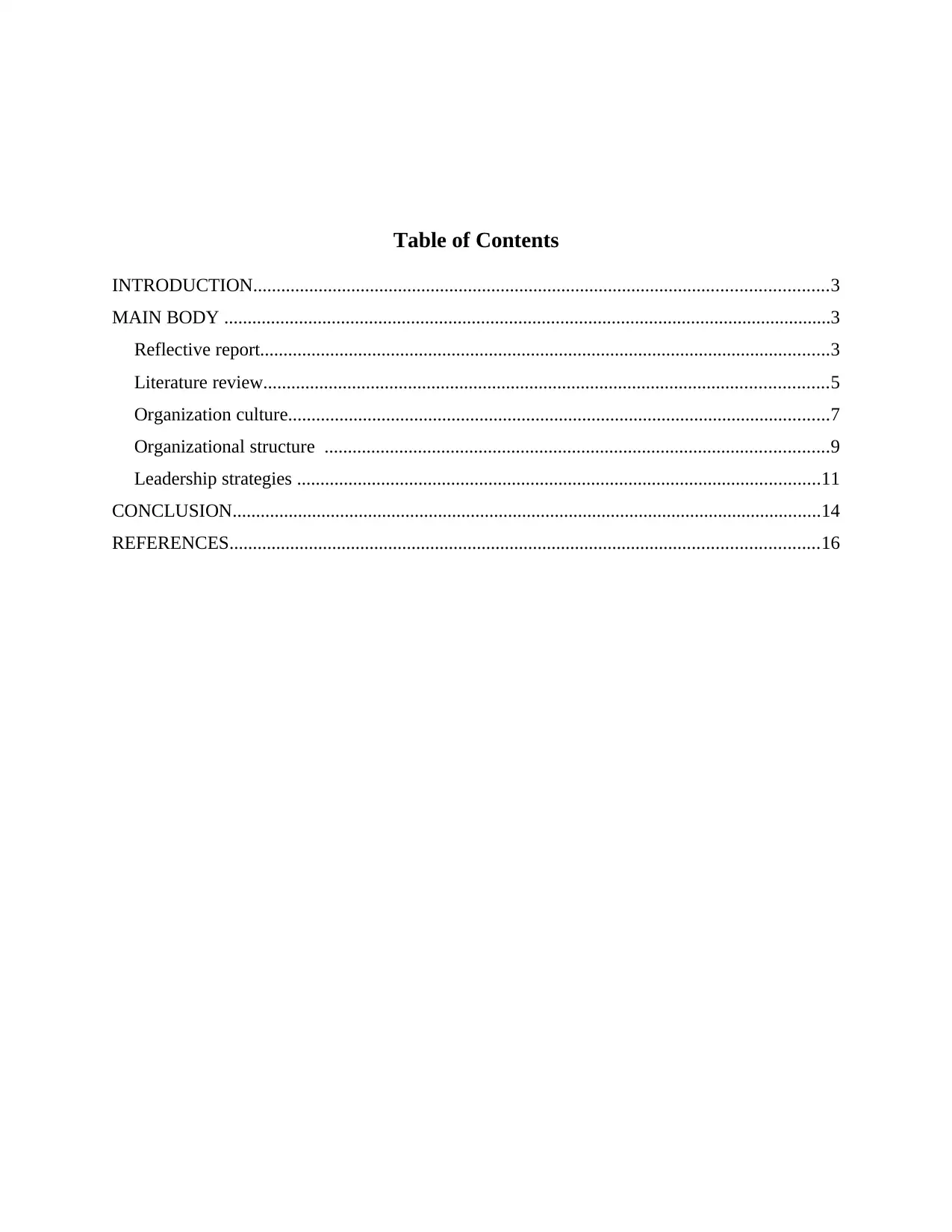
Table of Contents
INTRODUCTION...........................................................................................................................3
MAIN BODY ..................................................................................................................................3
Reflective report..........................................................................................................................3
Literature review.........................................................................................................................5
Organization culture....................................................................................................................7
Organizational structure ............................................................................................................9
Leadership strategies ................................................................................................................11
CONCLUSION..............................................................................................................................14
REFERENCES..............................................................................................................................16
INTRODUCTION...........................................................................................................................3
MAIN BODY ..................................................................................................................................3
Reflective report..........................................................................................................................3
Literature review.........................................................................................................................5
Organization culture....................................................................................................................7
Organizational structure ............................................................................................................9
Leadership strategies ................................................................................................................11
CONCLUSION..............................................................................................................................14
REFERENCES..............................................................................................................................16
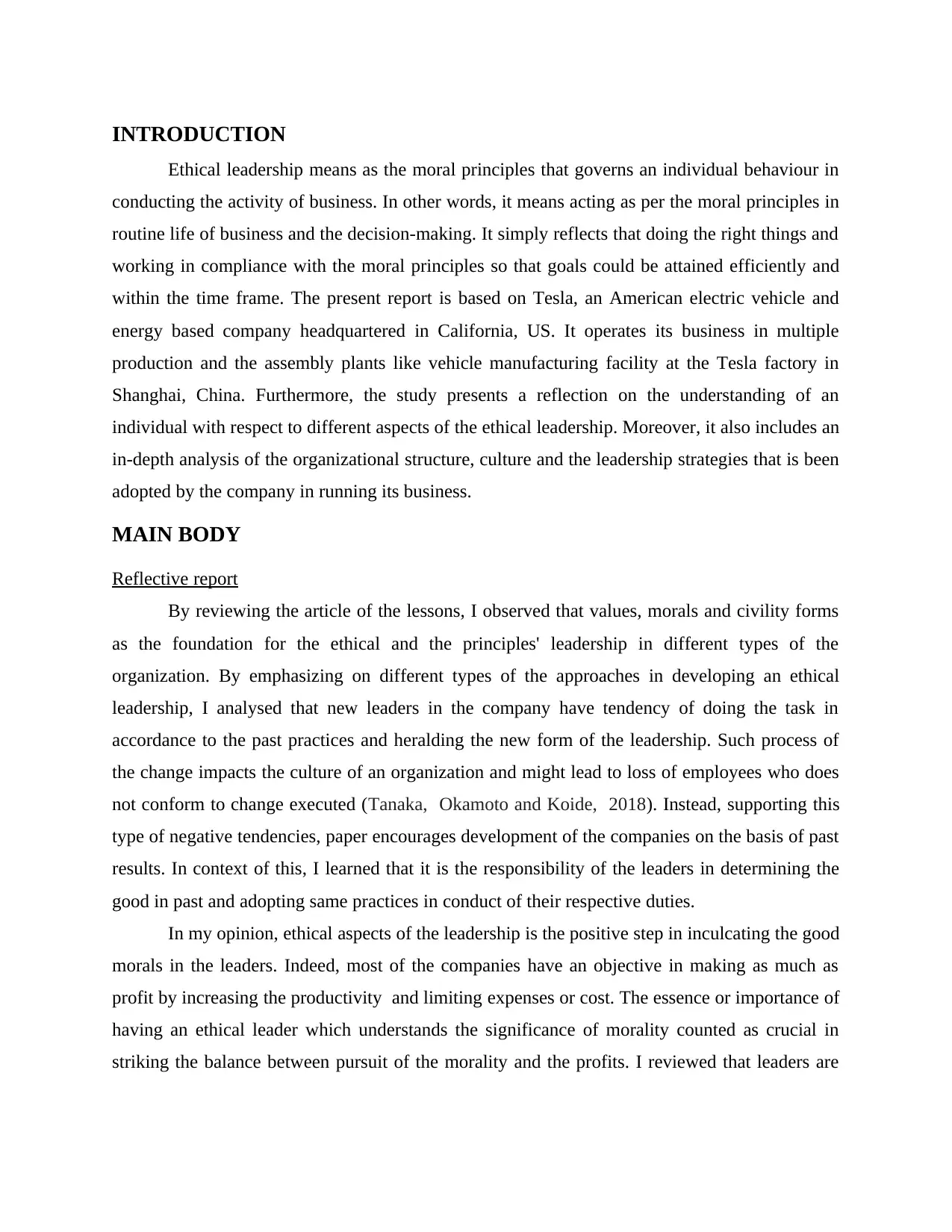
INTRODUCTION
Ethical leadership means as the moral principles that governs an individual behaviour in
conducting the activity of business. In other words, it means acting as per the moral principles in
routine life of business and the decision-making. It simply reflects that doing the right things and
working in compliance with the moral principles so that goals could be attained efficiently and
within the time frame. The present report is based on Tesla, an American electric vehicle and
energy based company headquartered in California, US. It operates its business in multiple
production and the assembly plants like vehicle manufacturing facility at the Tesla factory in
Shanghai, China. Furthermore, the study presents a reflection on the understanding of an
individual with respect to different aspects of the ethical leadership. Moreover, it also includes an
in-depth analysis of the organizational structure, culture and the leadership strategies that is been
adopted by the company in running its business.
MAIN BODY
Reflective report
By reviewing the article of the lessons, I observed that values, morals and civility forms
as the foundation for the ethical and the principles' leadership in different types of the
organization. By emphasizing on different types of the approaches in developing an ethical
leadership, I analysed that new leaders in the company have tendency of doing the task in
accordance to the past practices and heralding the new form of the leadership. Such process of
the change impacts the culture of an organization and might lead to loss of employees who does
not conform to change executed (Tanaka, Okamoto and Koide, 2018). Instead, supporting this
type of negative tendencies, paper encourages development of the companies on the basis of past
results. In context of this, I learned that it is the responsibility of the leaders in determining the
good in past and adopting same practices in conduct of their respective duties.
In my opinion, ethical aspects of the leadership is the positive step in inculcating the good
morals in the leaders. Indeed, most of the companies have an objective in making as much as
profit by increasing the productivity and limiting expenses or cost. The essence or importance of
having an ethical leader which understands the significance of morality counted as crucial in
striking the balance between pursuit of the morality and the profits. I reviewed that leaders are
Ethical leadership means as the moral principles that governs an individual behaviour in
conducting the activity of business. In other words, it means acting as per the moral principles in
routine life of business and the decision-making. It simply reflects that doing the right things and
working in compliance with the moral principles so that goals could be attained efficiently and
within the time frame. The present report is based on Tesla, an American electric vehicle and
energy based company headquartered in California, US. It operates its business in multiple
production and the assembly plants like vehicle manufacturing facility at the Tesla factory in
Shanghai, China. Furthermore, the study presents a reflection on the understanding of an
individual with respect to different aspects of the ethical leadership. Moreover, it also includes an
in-depth analysis of the organizational structure, culture and the leadership strategies that is been
adopted by the company in running its business.
MAIN BODY
Reflective report
By reviewing the article of the lessons, I observed that values, morals and civility forms
as the foundation for the ethical and the principles' leadership in different types of the
organization. By emphasizing on different types of the approaches in developing an ethical
leadership, I analysed that new leaders in the company have tendency of doing the task in
accordance to the past practices and heralding the new form of the leadership. Such process of
the change impacts the culture of an organization and might lead to loss of employees who does
not conform to change executed (Tanaka, Okamoto and Koide, 2018). Instead, supporting this
type of negative tendencies, paper encourages development of the companies on the basis of past
results. In context of this, I learned that it is the responsibility of the leaders in determining the
good in past and adopting same practices in conduct of their respective duties.
In my opinion, ethical aspects of the leadership is the positive step in inculcating the good
morals in the leaders. Indeed, most of the companies have an objective in making as much as
profit by increasing the productivity and limiting expenses or cost. The essence or importance of
having an ethical leader which understands the significance of morality counted as crucial in
striking the balance between pursuit of the morality and the profits. I reviewed that leaders are
⊘ This is a preview!⊘
Do you want full access?
Subscribe today to unlock all pages.

Trusted by 1+ million students worldwide
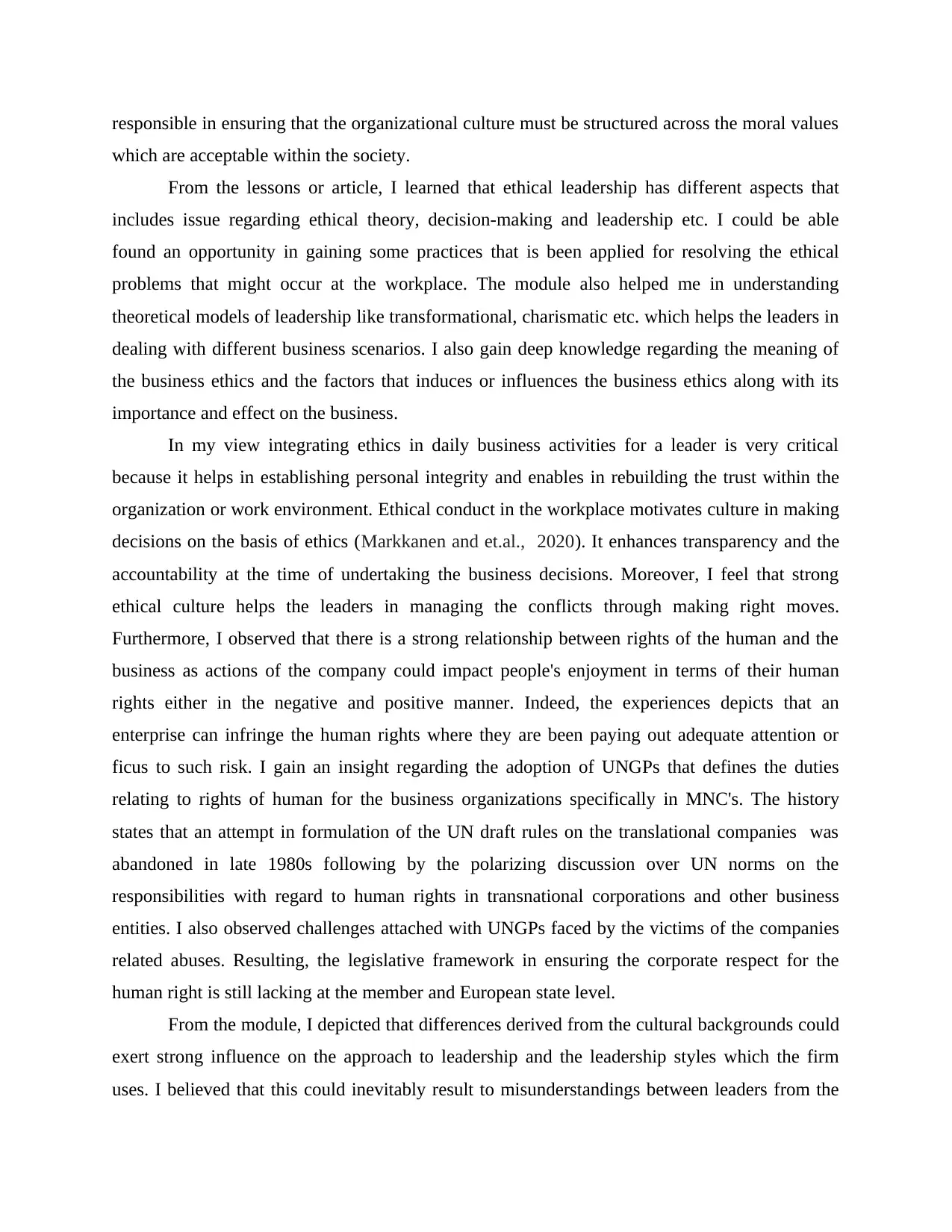
responsible in ensuring that the organizational culture must be structured across the moral values
which are acceptable within the society.
From the lessons or article, I learned that ethical leadership has different aspects that
includes issue regarding ethical theory, decision-making and leadership etc. I could be able
found an opportunity in gaining some practices that is been applied for resolving the ethical
problems that might occur at the workplace. The module also helped me in understanding
theoretical models of leadership like transformational, charismatic etc. which helps the leaders in
dealing with different business scenarios. I also gain deep knowledge regarding the meaning of
the business ethics and the factors that induces or influences the business ethics along with its
importance and effect on the business.
In my view integrating ethics in daily business activities for a leader is very critical
because it helps in establishing personal integrity and enables in rebuilding the trust within the
organization or work environment. Ethical conduct in the workplace motivates culture in making
decisions on the basis of ethics (Markkanen and et.al., 2020). It enhances transparency and the
accountability at the time of undertaking the business decisions. Moreover, I feel that strong
ethical culture helps the leaders in managing the conflicts through making right moves.
Furthermore, I observed that there is a strong relationship between rights of the human and the
business as actions of the company could impact people's enjoyment in terms of their human
rights either in the negative and positive manner. Indeed, the experiences depicts that an
enterprise can infringe the human rights where they are been paying out adequate attention or
ficus to such risk. I gain an insight regarding the adoption of UNGPs that defines the duties
relating to rights of human for the business organizations specifically in MNC's. The history
states that an attempt in formulation of the UN draft rules on the translational companies was
abandoned in late 1980s following by the polarizing discussion over UN norms on the
responsibilities with regard to human rights in transnational corporations and other business
entities. I also observed challenges attached with UNGPs faced by the victims of the companies
related abuses. Resulting, the legislative framework in ensuring the corporate respect for the
human right is still lacking at the member and European state level.
From the module, I depicted that differences derived from the cultural backgrounds could
exert strong influence on the approach to leadership and the leadership styles which the firm
uses. I believed that this could inevitably result to misunderstandings between leaders from the
which are acceptable within the society.
From the lessons or article, I learned that ethical leadership has different aspects that
includes issue regarding ethical theory, decision-making and leadership etc. I could be able
found an opportunity in gaining some practices that is been applied for resolving the ethical
problems that might occur at the workplace. The module also helped me in understanding
theoretical models of leadership like transformational, charismatic etc. which helps the leaders in
dealing with different business scenarios. I also gain deep knowledge regarding the meaning of
the business ethics and the factors that induces or influences the business ethics along with its
importance and effect on the business.
In my view integrating ethics in daily business activities for a leader is very critical
because it helps in establishing personal integrity and enables in rebuilding the trust within the
organization or work environment. Ethical conduct in the workplace motivates culture in making
decisions on the basis of ethics (Markkanen and et.al., 2020). It enhances transparency and the
accountability at the time of undertaking the business decisions. Moreover, I feel that strong
ethical culture helps the leaders in managing the conflicts through making right moves.
Furthermore, I observed that there is a strong relationship between rights of the human and the
business as actions of the company could impact people's enjoyment in terms of their human
rights either in the negative and positive manner. Indeed, the experiences depicts that an
enterprise can infringe the human rights where they are been paying out adequate attention or
ficus to such risk. I gain an insight regarding the adoption of UNGPs that defines the duties
relating to rights of human for the business organizations specifically in MNC's. The history
states that an attempt in formulation of the UN draft rules on the translational companies was
abandoned in late 1980s following by the polarizing discussion over UN norms on the
responsibilities with regard to human rights in transnational corporations and other business
entities. I also observed challenges attached with UNGPs faced by the victims of the companies
related abuses. Resulting, the legislative framework in ensuring the corporate respect for the
human right is still lacking at the member and European state level.
From the module, I depicted that differences derived from the cultural backgrounds could
exert strong influence on the approach to leadership and the leadership styles which the firm
uses. I believed that this could inevitably result to misunderstandings between leaders from the
Paraphrase This Document
Need a fresh take? Get an instant paraphrase of this document with our AI Paraphraser
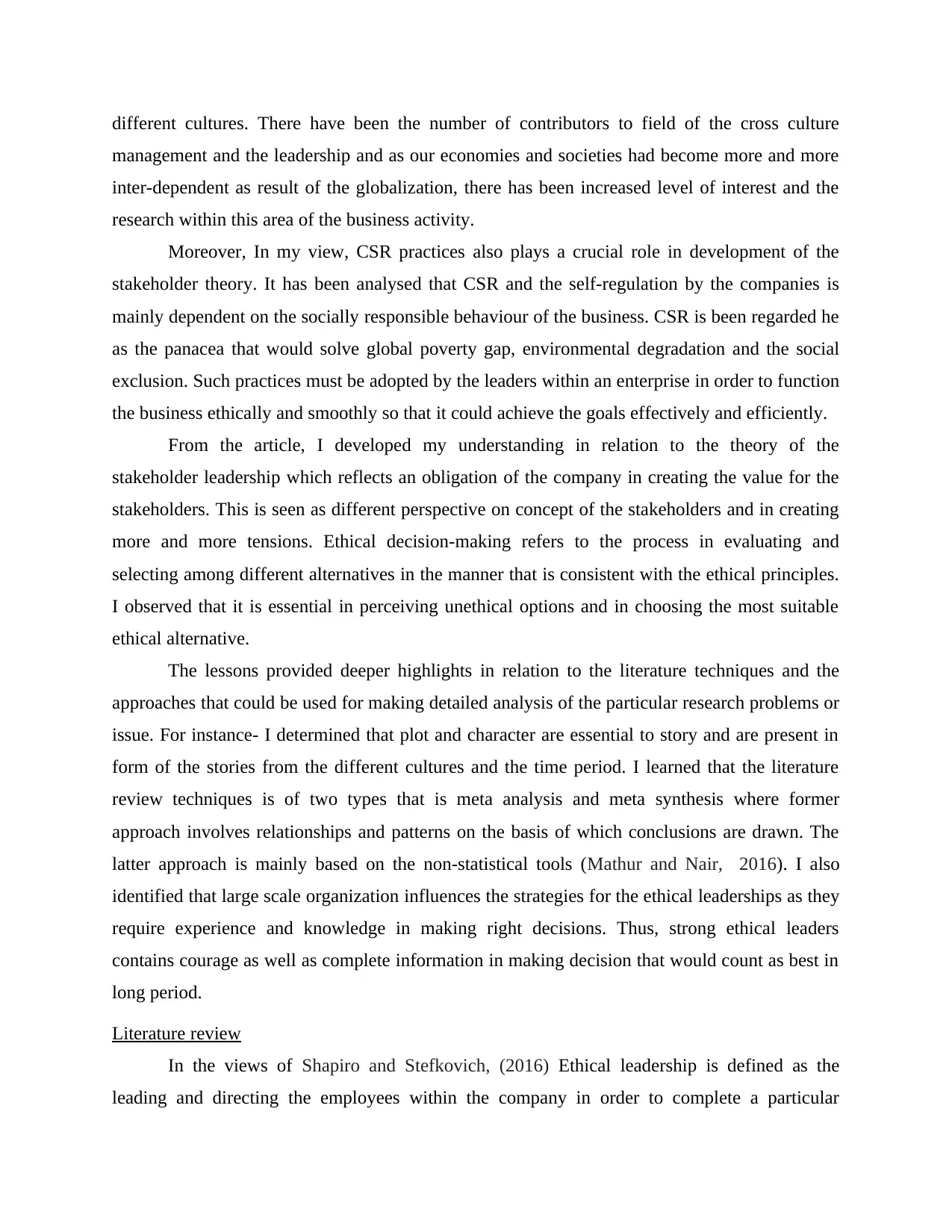
different cultures. There have been the number of contributors to field of the cross culture
management and the leadership and as our economies and societies had become more and more
inter-dependent as result of the globalization, there has been increased level of interest and the
research within this area of the business activity.
Moreover, In my view, CSR practices also plays a crucial role in development of the
stakeholder theory. It has been analysed that CSR and the self-regulation by the companies is
mainly dependent on the socially responsible behaviour of the business. CSR is been regarded he
as the panacea that would solve global poverty gap, environmental degradation and the social
exclusion. Such practices must be adopted by the leaders within an enterprise in order to function
the business ethically and smoothly so that it could achieve the goals effectively and efficiently.
From the article, I developed my understanding in relation to the theory of the
stakeholder leadership which reflects an obligation of the company in creating the value for the
stakeholders. This is seen as different perspective on concept of the stakeholders and in creating
more and more tensions. Ethical decision-making refers to the process in evaluating and
selecting among different alternatives in the manner that is consistent with the ethical principles.
I observed that it is essential in perceiving unethical options and in choosing the most suitable
ethical alternative.
The lessons provided deeper highlights in relation to the literature techniques and the
approaches that could be used for making detailed analysis of the particular research problems or
issue. For instance- I determined that plot and character are essential to story and are present in
form of the stories from the different cultures and the time period. I learned that the literature
review techniques is of two types that is meta analysis and meta synthesis where former
approach involves relationships and patterns on the basis of which conclusions are drawn. The
latter approach is mainly based on the non-statistical tools (Mathur and Nair, 2016). I also
identified that large scale organization influences the strategies for the ethical leaderships as they
require experience and knowledge in making right decisions. Thus, strong ethical leaders
contains courage as well as complete information in making decision that would count as best in
long period.
Literature review
In the views of Shapiro and Stefkovich, (2016) Ethical leadership is defined as the
leading and directing the employees within the company in order to complete a particular
management and the leadership and as our economies and societies had become more and more
inter-dependent as result of the globalization, there has been increased level of interest and the
research within this area of the business activity.
Moreover, In my view, CSR practices also plays a crucial role in development of the
stakeholder theory. It has been analysed that CSR and the self-regulation by the companies is
mainly dependent on the socially responsible behaviour of the business. CSR is been regarded he
as the panacea that would solve global poverty gap, environmental degradation and the social
exclusion. Such practices must be adopted by the leaders within an enterprise in order to function
the business ethically and smoothly so that it could achieve the goals effectively and efficiently.
From the article, I developed my understanding in relation to the theory of the
stakeholder leadership which reflects an obligation of the company in creating the value for the
stakeholders. This is seen as different perspective on concept of the stakeholders and in creating
more and more tensions. Ethical decision-making refers to the process in evaluating and
selecting among different alternatives in the manner that is consistent with the ethical principles.
I observed that it is essential in perceiving unethical options and in choosing the most suitable
ethical alternative.
The lessons provided deeper highlights in relation to the literature techniques and the
approaches that could be used for making detailed analysis of the particular research problems or
issue. For instance- I determined that plot and character are essential to story and are present in
form of the stories from the different cultures and the time period. I learned that the literature
review techniques is of two types that is meta analysis and meta synthesis where former
approach involves relationships and patterns on the basis of which conclusions are drawn. The
latter approach is mainly based on the non-statistical tools (Mathur and Nair, 2016). I also
identified that large scale organization influences the strategies for the ethical leaderships as they
require experience and knowledge in making right decisions. Thus, strong ethical leaders
contains courage as well as complete information in making decision that would count as best in
long period.
Literature review
In the views of Shapiro and Stefkovich, (2016) Ethical leadership is defined as the
leading and directing the employees within the company in order to complete a particular
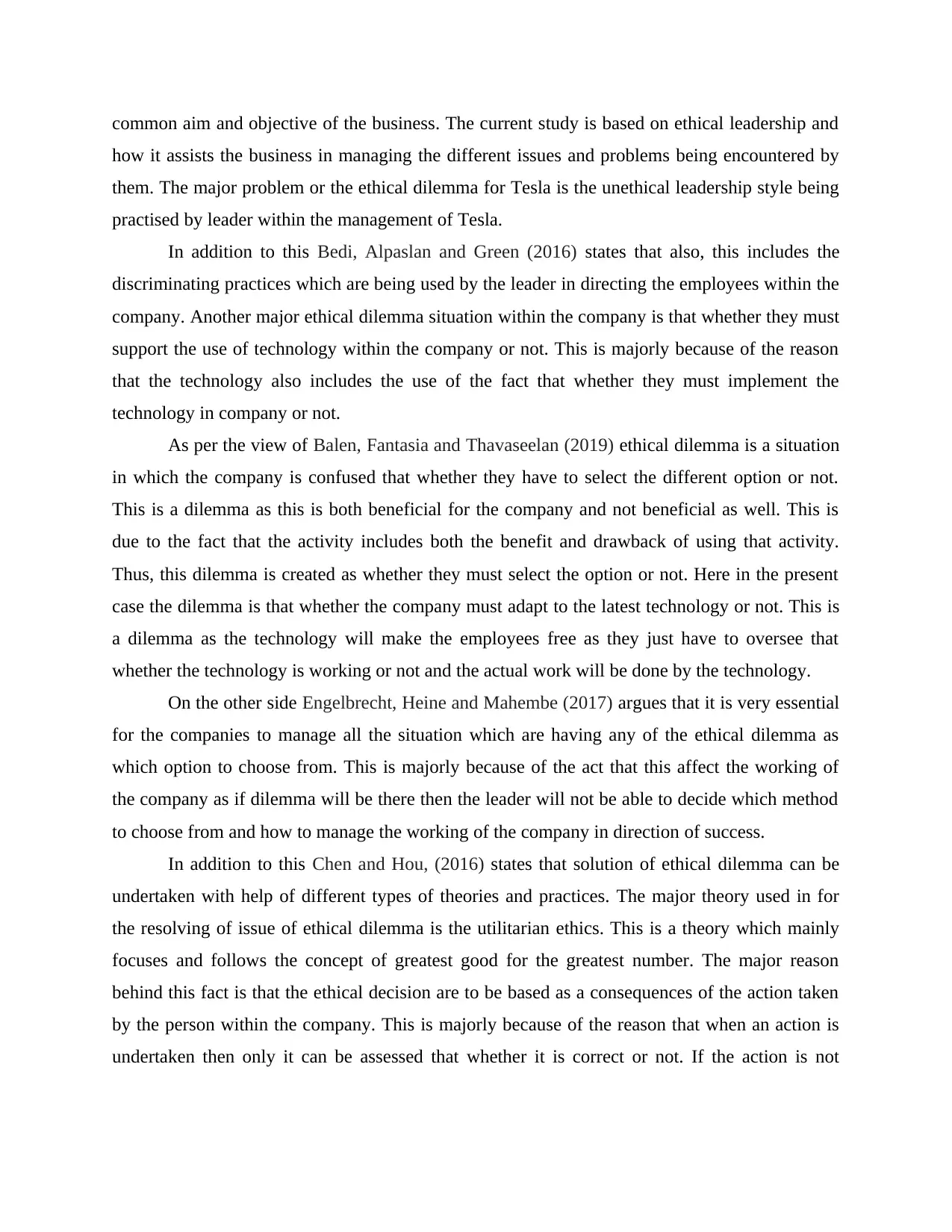
common aim and objective of the business. The current study is based on ethical leadership and
how it assists the business in managing the different issues and problems being encountered by
them. The major problem or the ethical dilemma for Tesla is the unethical leadership style being
practised by leader within the management of Tesla.
In addition to this Bedi, Alpaslan and Green (2016) states that also, this includes the
discriminating practices which are being used by the leader in directing the employees within the
company. Another major ethical dilemma situation within the company is that whether they must
support the use of technology within the company or not. This is majorly because of the reason
that the technology also includes the use of the fact that whether they must implement the
technology in company or not.
As per the view of Balen, Fantasia and Thavaseelan (2019) ethical dilemma is a situation
in which the company is confused that whether they have to select the different option or not.
This is a dilemma as this is both beneficial for the company and not beneficial as well. This is
due to the fact that the activity includes both the benefit and drawback of using that activity.
Thus, this dilemma is created as whether they must select the option or not. Here in the present
case the dilemma is that whether the company must adapt to the latest technology or not. This is
a dilemma as the technology will make the employees free as they just have to oversee that
whether the technology is working or not and the actual work will be done by the technology.
On the other side Engelbrecht, Heine and Mahembe (2017) argues that it is very essential
for the companies to manage all the situation which are having any of the ethical dilemma as
which option to choose from. This is majorly because of the act that this affect the working of
the company as if dilemma will be there then the leader will not be able to decide which method
to choose from and how to manage the working of the company in direction of success.
In addition to this Chen and Hou, (2016) states that solution of ethical dilemma can be
undertaken with help of different types of theories and practices. The major theory used in for
the resolving of issue of ethical dilemma is the utilitarian ethics. This is a theory which mainly
focuses and follows the concept of greatest good for the greatest number. The major reason
behind this fact is that the ethical decision are to be based as a consequences of the action taken
by the person within the company. This is majorly because of the reason that when an action is
undertaken then only it can be assessed that whether it is correct or not. If the action is not
how it assists the business in managing the different issues and problems being encountered by
them. The major problem or the ethical dilemma for Tesla is the unethical leadership style being
practised by leader within the management of Tesla.
In addition to this Bedi, Alpaslan and Green (2016) states that also, this includes the
discriminating practices which are being used by the leader in directing the employees within the
company. Another major ethical dilemma situation within the company is that whether they must
support the use of technology within the company or not. This is majorly because of the reason
that the technology also includes the use of the fact that whether they must implement the
technology in company or not.
As per the view of Balen, Fantasia and Thavaseelan (2019) ethical dilemma is a situation
in which the company is confused that whether they have to select the different option or not.
This is a dilemma as this is both beneficial for the company and not beneficial as well. This is
due to the fact that the activity includes both the benefit and drawback of using that activity.
Thus, this dilemma is created as whether they must select the option or not. Here in the present
case the dilemma is that whether the company must adapt to the latest technology or not. This is
a dilemma as the technology will make the employees free as they just have to oversee that
whether the technology is working or not and the actual work will be done by the technology.
On the other side Engelbrecht, Heine and Mahembe (2017) argues that it is very essential
for the companies to manage all the situation which are having any of the ethical dilemma as
which option to choose from. This is majorly because of the act that this affect the working of
the company as if dilemma will be there then the leader will not be able to decide which method
to choose from and how to manage the working of the company in direction of success.
In addition to this Chen and Hou, (2016) states that solution of ethical dilemma can be
undertaken with help of different types of theories and practices. The major theory used in for
the resolving of issue of ethical dilemma is the utilitarian ethics. This is a theory which mainly
focuses and follows the concept of greatest good for the greatest number. The major reason
behind this fact is that the ethical decision are to be based as a consequences of the action taken
by the person within the company. This is majorly because of the reason that when an action is
undertaken then only it can be assessed that whether it is correct or not. If the action is not
⊘ This is a preview!⊘
Do you want full access?
Subscribe today to unlock all pages.

Trusted by 1+ million students worldwide
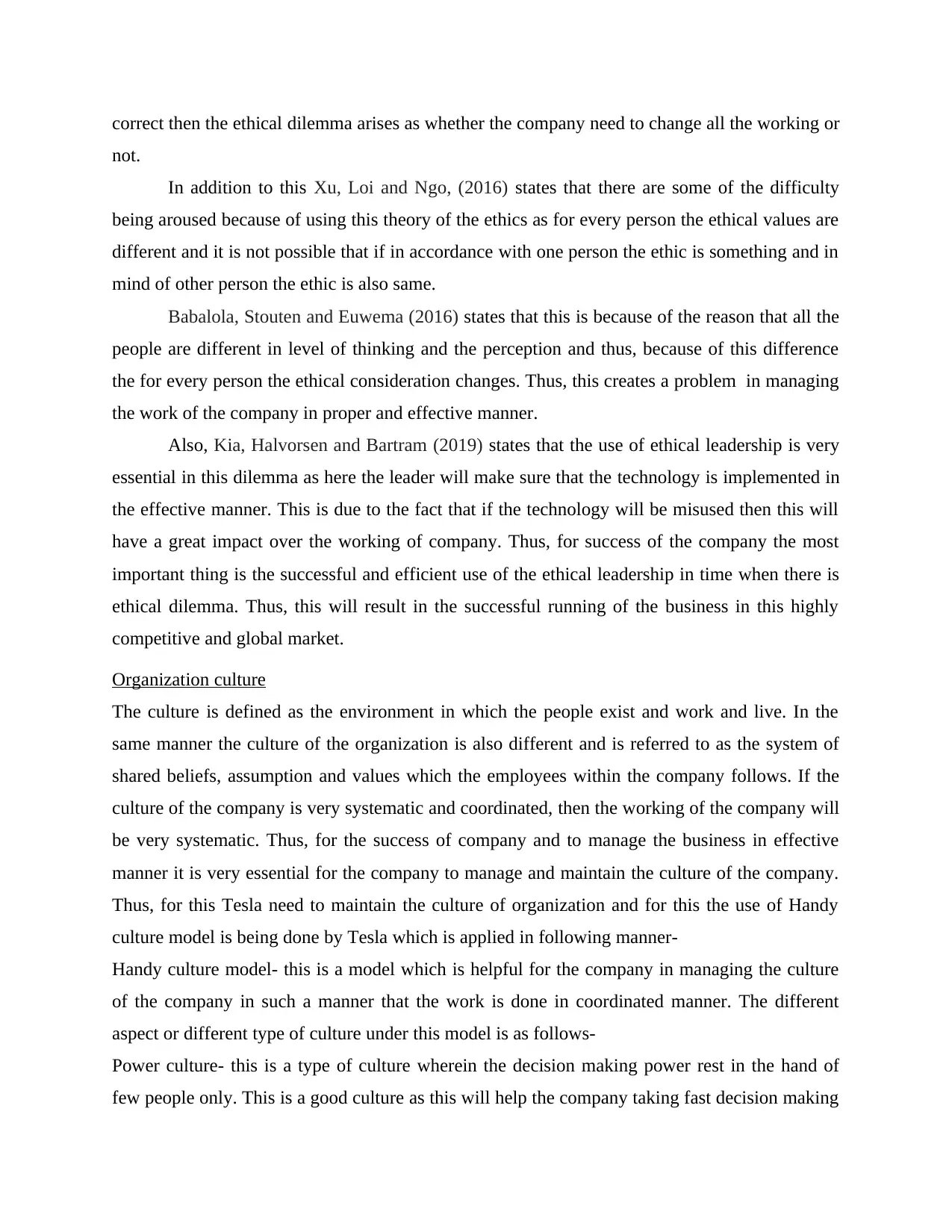
correct then the ethical dilemma arises as whether the company need to change all the working or
not.
In addition to this Xu, Loi and Ngo, (2016) states that there are some of the difficulty
being aroused because of using this theory of the ethics as for every person the ethical values are
different and it is not possible that if in accordance with one person the ethic is something and in
mind of other person the ethic is also same.
Babalola, Stouten and Euwema (2016) states that this is because of the reason that all the
people are different in level of thinking and the perception and thus, because of this difference
the for every person the ethical consideration changes. Thus, this creates a problem in managing
the work of the company in proper and effective manner.
Also, Kia, Halvorsen and Bartram (2019) states that the use of ethical leadership is very
essential in this dilemma as here the leader will make sure that the technology is implemented in
the effective manner. This is due to the fact that if the technology will be misused then this will
have a great impact over the working of company. Thus, for success of the company the most
important thing is the successful and efficient use of the ethical leadership in time when there is
ethical dilemma. Thus, this will result in the successful running of the business in this highly
competitive and global market.
Organization culture
The culture is defined as the environment in which the people exist and work and live. In the
same manner the culture of the organization is also different and is referred to as the system of
shared beliefs, assumption and values which the employees within the company follows. If the
culture of the company is very systematic and coordinated, then the working of the company will
be very systematic. Thus, for the success of company and to manage the business in effective
manner it is very essential for the company to manage and maintain the culture of the company.
Thus, for this Tesla need to maintain the culture of organization and for this the use of Handy
culture model is being done by Tesla which is applied in following manner-
Handy culture model- this is a model which is helpful for the company in managing the culture
of the company in such a manner that the work is done in coordinated manner. The different
aspect or different type of culture under this model is as follows-
Power culture- this is a type of culture wherein the decision making power rest in the hand of
few people only. This is a good culture as this will help the company taking fast decision making
not.
In addition to this Xu, Loi and Ngo, (2016) states that there are some of the difficulty
being aroused because of using this theory of the ethics as for every person the ethical values are
different and it is not possible that if in accordance with one person the ethic is something and in
mind of other person the ethic is also same.
Babalola, Stouten and Euwema (2016) states that this is because of the reason that all the
people are different in level of thinking and the perception and thus, because of this difference
the for every person the ethical consideration changes. Thus, this creates a problem in managing
the work of the company in proper and effective manner.
Also, Kia, Halvorsen and Bartram (2019) states that the use of ethical leadership is very
essential in this dilemma as here the leader will make sure that the technology is implemented in
the effective manner. This is due to the fact that if the technology will be misused then this will
have a great impact over the working of company. Thus, for success of the company the most
important thing is the successful and efficient use of the ethical leadership in time when there is
ethical dilemma. Thus, this will result in the successful running of the business in this highly
competitive and global market.
Organization culture
The culture is defined as the environment in which the people exist and work and live. In the
same manner the culture of the organization is also different and is referred to as the system of
shared beliefs, assumption and values which the employees within the company follows. If the
culture of the company is very systematic and coordinated, then the working of the company will
be very systematic. Thus, for the success of company and to manage the business in effective
manner it is very essential for the company to manage and maintain the culture of the company.
Thus, for this Tesla need to maintain the culture of organization and for this the use of Handy
culture model is being done by Tesla which is applied in following manner-
Handy culture model- this is a model which is helpful for the company in managing the culture
of the company in such a manner that the work is done in coordinated manner. The different
aspect or different type of culture under this model is as follows-
Power culture- this is a type of culture wherein the decision making power rest in the hand of
few people only. This is a good culture as this will help the company taking fast decision making
Paraphrase This Document
Need a fresh take? Get an instant paraphrase of this document with our AI Paraphraser
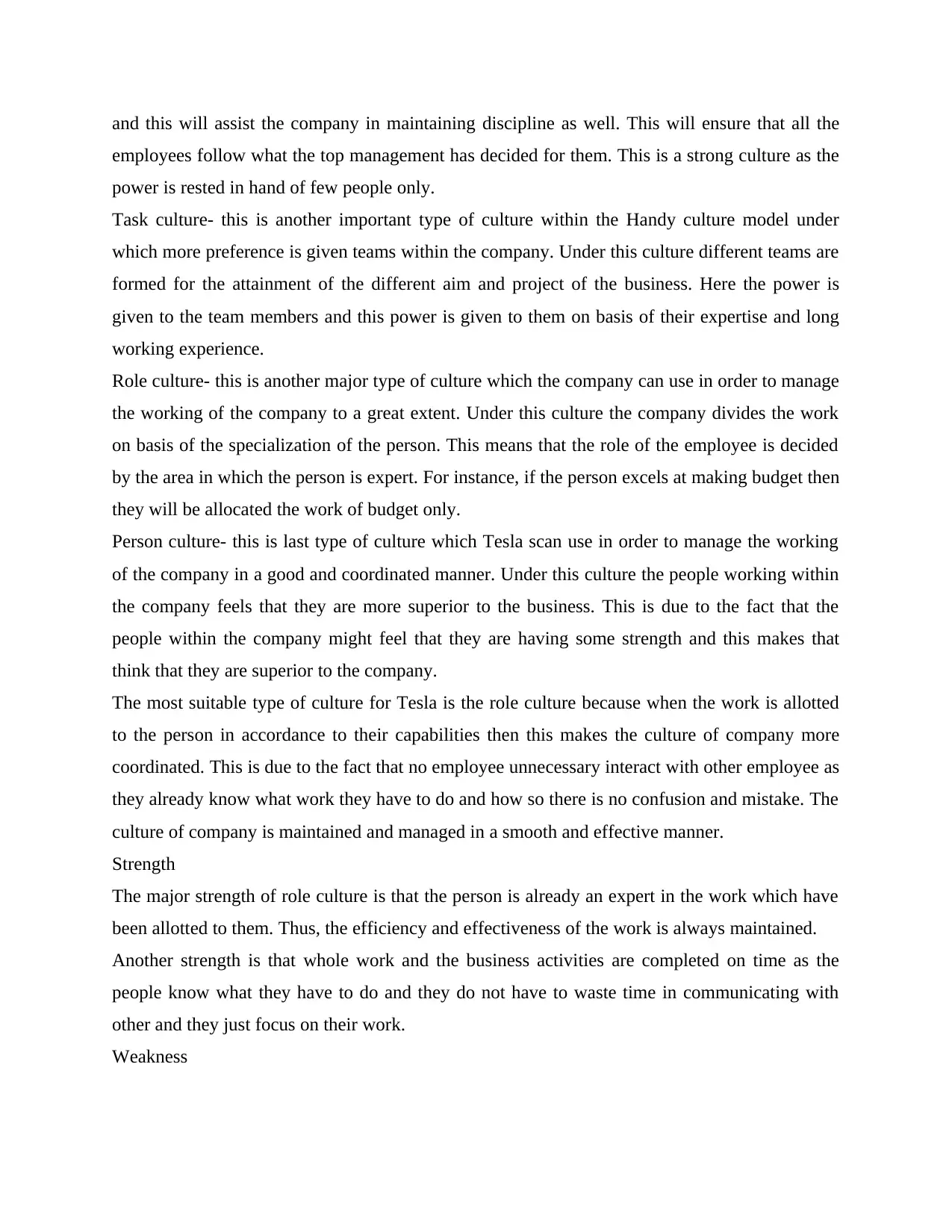
and this will assist the company in maintaining discipline as well. This will ensure that all the
employees follow what the top management has decided for them. This is a strong culture as the
power is rested in hand of few people only.
Task culture- this is another important type of culture within the Handy culture model under
which more preference is given teams within the company. Under this culture different teams are
formed for the attainment of the different aim and project of the business. Here the power is
given to the team members and this power is given to them on basis of their expertise and long
working experience.
Role culture- this is another major type of culture which the company can use in order to manage
the working of the company to a great extent. Under this culture the company divides the work
on basis of the specialization of the person. This means that the role of the employee is decided
by the area in which the person is expert. For instance, if the person excels at making budget then
they will be allocated the work of budget only.
Person culture- this is last type of culture which Tesla scan use in order to manage the working
of the company in a good and coordinated manner. Under this culture the people working within
the company feels that they are more superior to the business. This is due to the fact that the
people within the company might feel that they are having some strength and this makes that
think that they are superior to the company.
The most suitable type of culture for Tesla is the role culture because when the work is allotted
to the person in accordance to their capabilities then this makes the culture of company more
coordinated. This is due to the fact that no employee unnecessary interact with other employee as
they already know what work they have to do and how so there is no confusion and mistake. The
culture of company is maintained and managed in a smooth and effective manner.
Strength
The major strength of role culture is that the person is already an expert in the work which have
been allotted to them. Thus, the efficiency and effectiveness of the work is always maintained.
Another strength is that whole work and the business activities are completed on time as the
people know what they have to do and they do not have to waste time in communicating with
other and they just focus on their work.
Weakness
employees follow what the top management has decided for them. This is a strong culture as the
power is rested in hand of few people only.
Task culture- this is another important type of culture within the Handy culture model under
which more preference is given teams within the company. Under this culture different teams are
formed for the attainment of the different aim and project of the business. Here the power is
given to the team members and this power is given to them on basis of their expertise and long
working experience.
Role culture- this is another major type of culture which the company can use in order to manage
the working of the company to a great extent. Under this culture the company divides the work
on basis of the specialization of the person. This means that the role of the employee is decided
by the area in which the person is expert. For instance, if the person excels at making budget then
they will be allocated the work of budget only.
Person culture- this is last type of culture which Tesla scan use in order to manage the working
of the company in a good and coordinated manner. Under this culture the people working within
the company feels that they are more superior to the business. This is due to the fact that the
people within the company might feel that they are having some strength and this makes that
think that they are superior to the company.
The most suitable type of culture for Tesla is the role culture because when the work is allotted
to the person in accordance to their capabilities then this makes the culture of company more
coordinated. This is due to the fact that no employee unnecessary interact with other employee as
they already know what work they have to do and how so there is no confusion and mistake. The
culture of company is maintained and managed in a smooth and effective manner.
Strength
The major strength of role culture is that the person is already an expert in the work which have
been allotted to them. Thus, the efficiency and effectiveness of the work is always maintained.
Another strength is that whole work and the business activities are completed on time as the
people know what they have to do and they do not have to waste time in communicating with
other and they just focus on their work.
Weakness
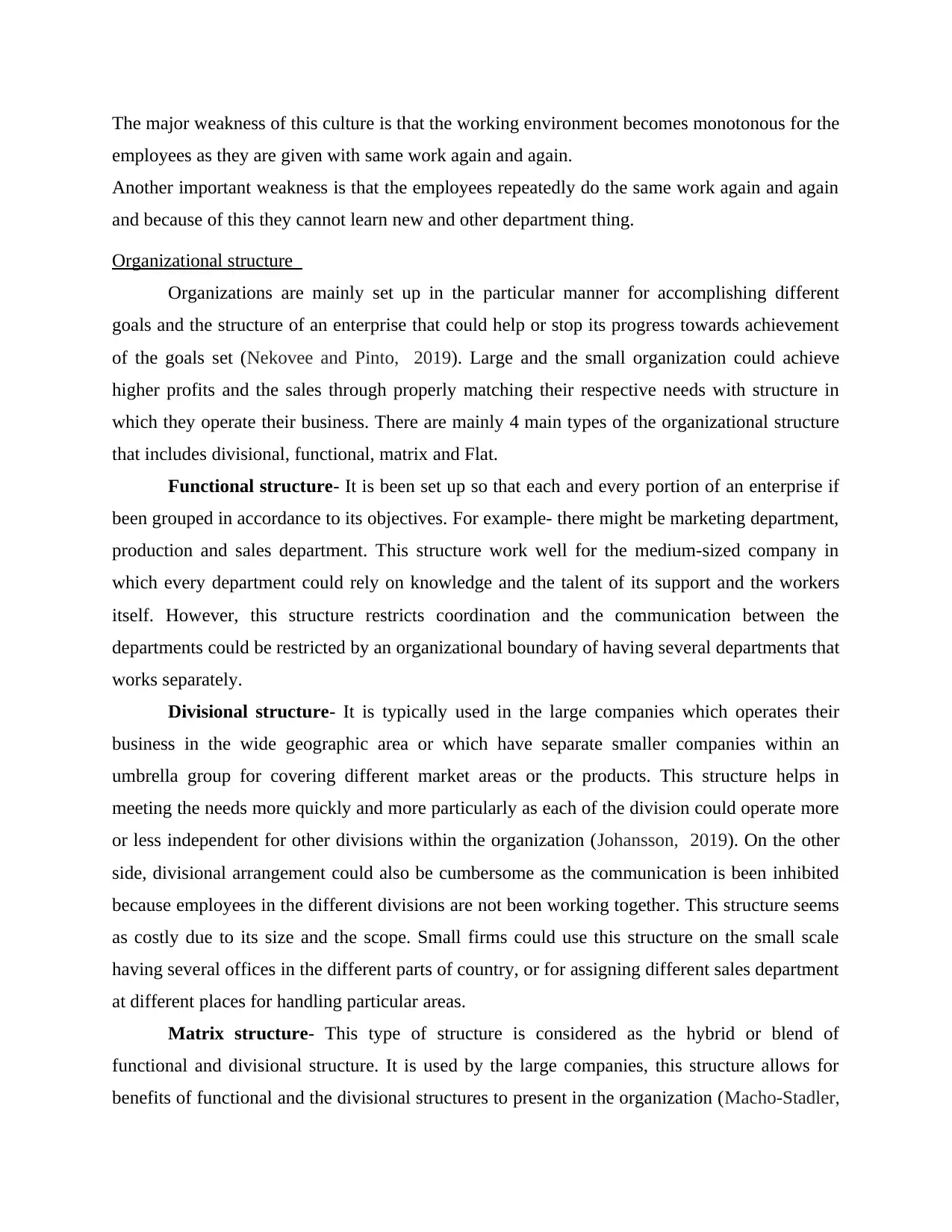
The major weakness of this culture is that the working environment becomes monotonous for the
employees as they are given with same work again and again.
Another important weakness is that the employees repeatedly do the same work again and again
and because of this they cannot learn new and other department thing.
Organizational structure
Organizations are mainly set up in the particular manner for accomplishing different
goals and the structure of an enterprise that could help or stop its progress towards achievement
of the goals set (Nekovee and Pinto, 2019). Large and the small organization could achieve
higher profits and the sales through properly matching their respective needs with structure in
which they operate their business. There are mainly 4 main types of the organizational structure
that includes divisional, functional, matrix and Flat.
Functional structure- It is been set up so that each and every portion of an enterprise if
been grouped in accordance to its objectives. For example- there might be marketing department,
production and sales department. This structure work well for the medium-sized company in
which every department could rely on knowledge and the talent of its support and the workers
itself. However, this structure restricts coordination and the communication between the
departments could be restricted by an organizational boundary of having several departments that
works separately.
Divisional structure- It is typically used in the large companies which operates their
business in the wide geographic area or which have separate smaller companies within an
umbrella group for covering different market areas or the products. This structure helps in
meeting the needs more quickly and more particularly as each of the division could operate more
or less independent for other divisions within the organization (Johansson, 2019). On the other
side, divisional arrangement could also be cumbersome as the communication is been inhibited
because employees in the different divisions are not been working together. This structure seems
as costly due to its size and the scope. Small firms could use this structure on the small scale
having several offices in the different parts of country, or for assigning different sales department
at different places for handling particular areas.
Matrix structure- This type of structure is considered as the hybrid or blend of
functional and divisional structure. It is used by the large companies, this structure allows for
benefits of functional and the divisional structures to present in the organization (Macho-Stadler,
employees as they are given with same work again and again.
Another important weakness is that the employees repeatedly do the same work again and again
and because of this they cannot learn new and other department thing.
Organizational structure
Organizations are mainly set up in the particular manner for accomplishing different
goals and the structure of an enterprise that could help or stop its progress towards achievement
of the goals set (Nekovee and Pinto, 2019). Large and the small organization could achieve
higher profits and the sales through properly matching their respective needs with structure in
which they operate their business. There are mainly 4 main types of the organizational structure
that includes divisional, functional, matrix and Flat.
Functional structure- It is been set up so that each and every portion of an enterprise if
been grouped in accordance to its objectives. For example- there might be marketing department,
production and sales department. This structure work well for the medium-sized company in
which every department could rely on knowledge and the talent of its support and the workers
itself. However, this structure restricts coordination and the communication between the
departments could be restricted by an organizational boundary of having several departments that
works separately.
Divisional structure- It is typically used in the large companies which operates their
business in the wide geographic area or which have separate smaller companies within an
umbrella group for covering different market areas or the products. This structure helps in
meeting the needs more quickly and more particularly as each of the division could operate more
or less independent for other divisions within the organization (Johansson, 2019). On the other
side, divisional arrangement could also be cumbersome as the communication is been inhibited
because employees in the different divisions are not been working together. This structure seems
as costly due to its size and the scope. Small firms could use this structure on the small scale
having several offices in the different parts of country, or for assigning different sales department
at different places for handling particular areas.
Matrix structure- This type of structure is considered as the hybrid or blend of
functional and divisional structure. It is used by the large companies, this structure allows for
benefits of functional and the divisional structures to present in the organization (Macho-Stadler,
⊘ This is a preview!⊘
Do you want full access?
Subscribe today to unlock all pages.

Trusted by 1+ million students worldwide
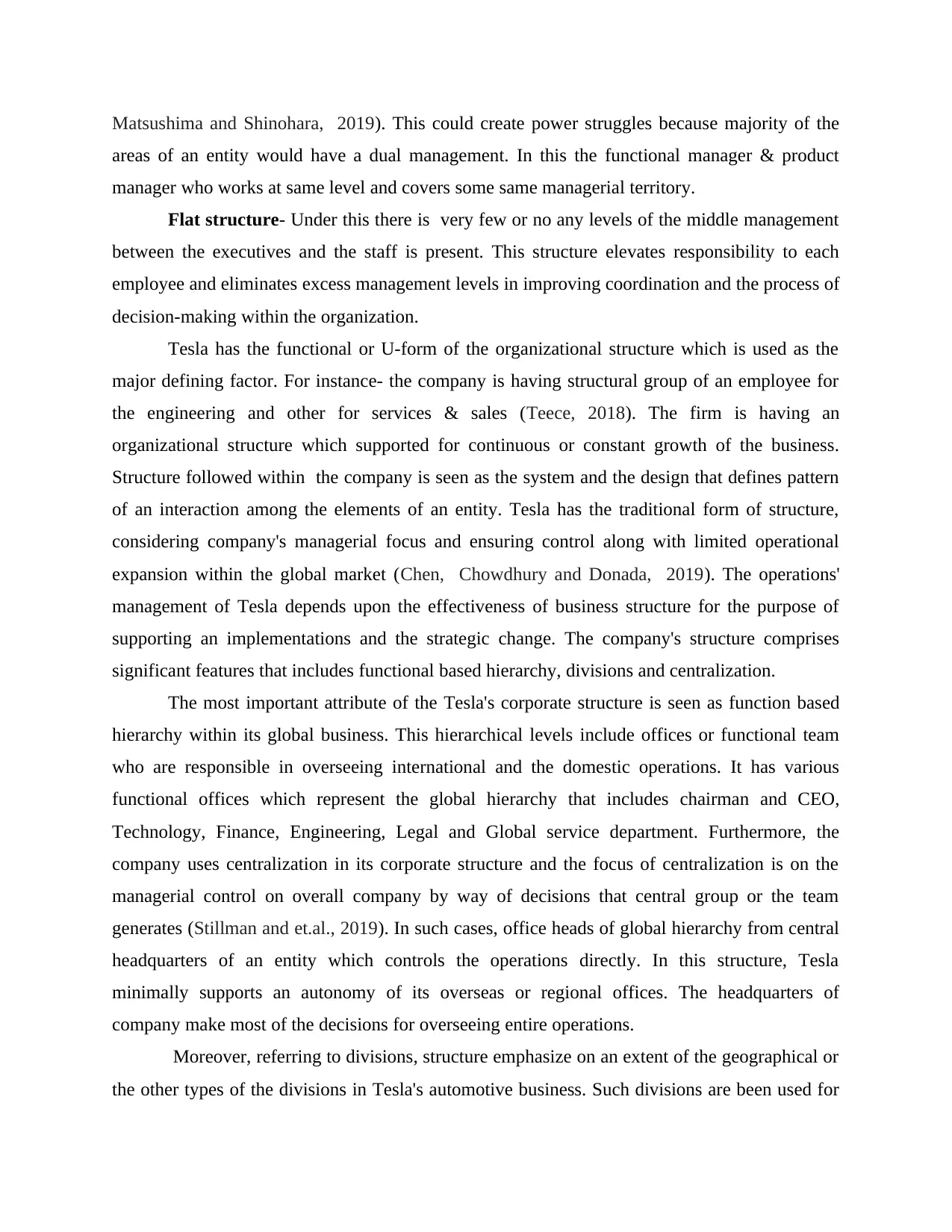
Matsushima and Shinohara, 2019). This could create power struggles because majority of the
areas of an entity would have a dual management. In this the functional manager & product
manager who works at same level and covers some same managerial territory.
Flat structure- Under this there is very few or no any levels of the middle management
between the executives and the staff is present. This structure elevates responsibility to each
employee and eliminates excess management levels in improving coordination and the process of
decision-making within the organization.
Tesla has the functional or U-form of the organizational structure which is used as the
major defining factor. For instance- the company is having structural group of an employee for
the engineering and other for services & sales (Teece, 2018). The firm is having an
organizational structure which supported for continuous or constant growth of the business.
Structure followed within the company is seen as the system and the design that defines pattern
of an interaction among the elements of an entity. Tesla has the traditional form of structure,
considering company's managerial focus and ensuring control along with limited operational
expansion within the global market (Chen, Chowdhury and Donada, 2019). The operations'
management of Tesla depends upon the effectiveness of business structure for the purpose of
supporting an implementations and the strategic change. The company's structure comprises
significant features that includes functional based hierarchy, divisions and centralization.
The most important attribute of the Tesla's corporate structure is seen as function based
hierarchy within its global business. This hierarchical levels include offices or functional team
who are responsible in overseeing international and the domestic operations. It has various
functional offices which represent the global hierarchy that includes chairman and CEO,
Technology, Finance, Engineering, Legal and Global service department. Furthermore, the
company uses centralization in its corporate structure and the focus of centralization is on the
managerial control on overall company by way of decisions that central group or the team
generates (Stillman and et.al., 2019). In such cases, office heads of global hierarchy from central
headquarters of an entity which controls the operations directly. In this structure, Tesla
minimally supports an autonomy of its overseas or regional offices. The headquarters of
company make most of the decisions for overseeing entire operations.
Moreover, referring to divisions, structure emphasize on an extent of the geographical or
the other types of the divisions in Tesla's automotive business. Such divisions are been used for
areas of an entity would have a dual management. In this the functional manager & product
manager who works at same level and covers some same managerial territory.
Flat structure- Under this there is very few or no any levels of the middle management
between the executives and the staff is present. This structure elevates responsibility to each
employee and eliminates excess management levels in improving coordination and the process of
decision-making within the organization.
Tesla has the functional or U-form of the organizational structure which is used as the
major defining factor. For instance- the company is having structural group of an employee for
the engineering and other for services & sales (Teece, 2018). The firm is having an
organizational structure which supported for continuous or constant growth of the business.
Structure followed within the company is seen as the system and the design that defines pattern
of an interaction among the elements of an entity. Tesla has the traditional form of structure,
considering company's managerial focus and ensuring control along with limited operational
expansion within the global market (Chen, Chowdhury and Donada, 2019). The operations'
management of Tesla depends upon the effectiveness of business structure for the purpose of
supporting an implementations and the strategic change. The company's structure comprises
significant features that includes functional based hierarchy, divisions and centralization.
The most important attribute of the Tesla's corporate structure is seen as function based
hierarchy within its global business. This hierarchical levels include offices or functional team
who are responsible in overseeing international and the domestic operations. It has various
functional offices which represent the global hierarchy that includes chairman and CEO,
Technology, Finance, Engineering, Legal and Global service department. Furthermore, the
company uses centralization in its corporate structure and the focus of centralization is on the
managerial control on overall company by way of decisions that central group or the team
generates (Stillman and et.al., 2019). In such cases, office heads of global hierarchy from central
headquarters of an entity which controls the operations directly. In this structure, Tesla
minimally supports an autonomy of its overseas or regional offices. The headquarters of
company make most of the decisions for overseeing entire operations.
Moreover, referring to divisions, structure emphasize on an extent of the geographical or
the other types of the divisions in Tesla's automotive business. Such divisions are been used for
Paraphrase This Document
Need a fresh take? Get an instant paraphrase of this document with our AI Paraphraser
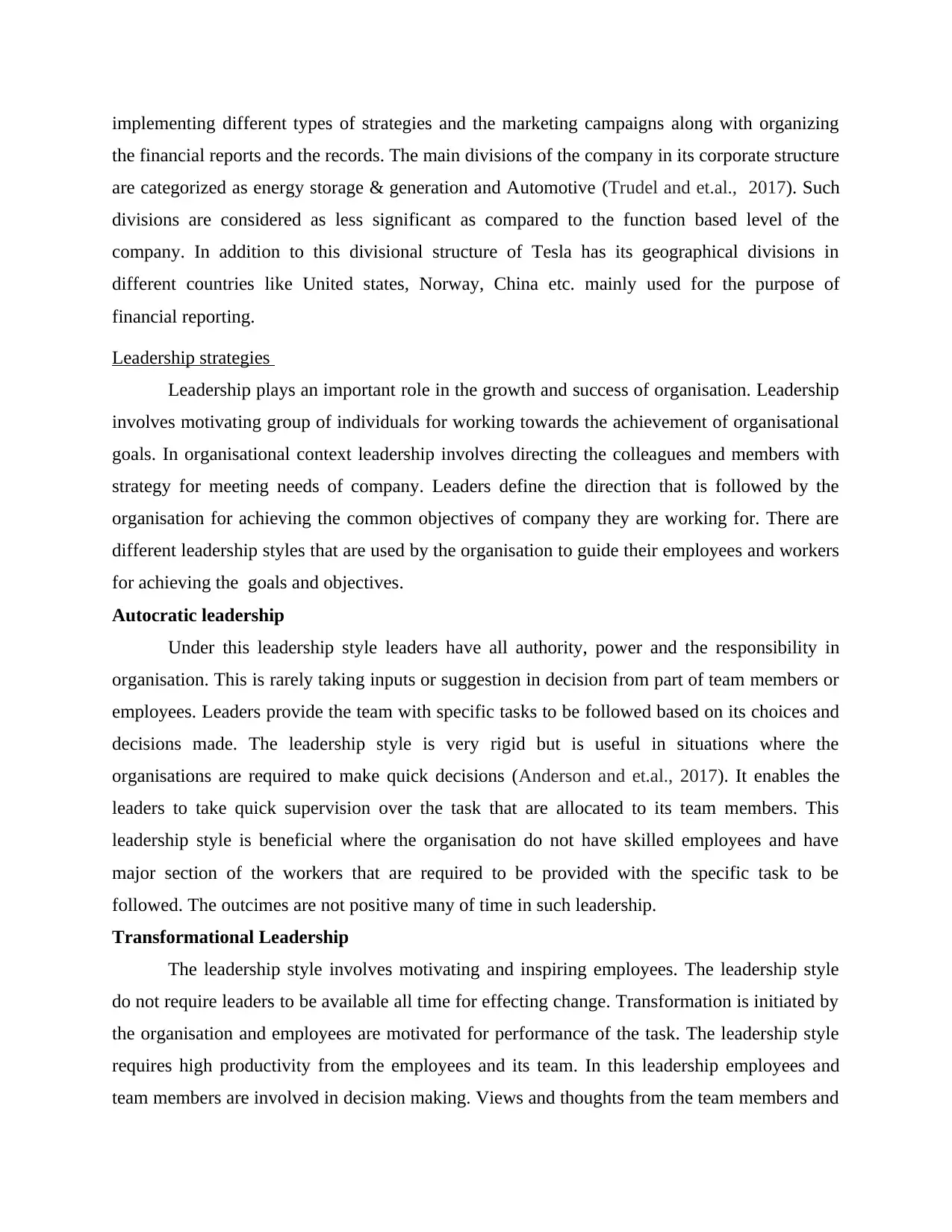
implementing different types of strategies and the marketing campaigns along with organizing
the financial reports and the records. The main divisions of the company in its corporate structure
are categorized as energy storage & generation and Automotive (Trudel and et.al., 2017). Such
divisions are considered as less significant as compared to the function based level of the
company. In addition to this divisional structure of Tesla has its geographical divisions in
different countries like United states, Norway, China etc. mainly used for the purpose of
financial reporting.
Leadership strategies
Leadership plays an important role in the growth and success of organisation. Leadership
involves motivating group of individuals for working towards the achievement of organisational
goals. In organisational context leadership involves directing the colleagues and members with
strategy for meeting needs of company. Leaders define the direction that is followed by the
organisation for achieving the common objectives of company they are working for. There are
different leadership styles that are used by the organisation to guide their employees and workers
for achieving the goals and objectives.
Autocratic leadership
Under this leadership style leaders have all authority, power and the responsibility in
organisation. This is rarely taking inputs or suggestion in decision from part of team members or
employees. Leaders provide the team with specific tasks to be followed based on its choices and
decisions made. The leadership style is very rigid but is useful in situations where the
organisations are required to make quick decisions (Anderson and et.al., 2017). It enables the
leaders to take quick supervision over the task that are allocated to its team members. This
leadership style is beneficial where the organisation do not have skilled employees and have
major section of the workers that are required to be provided with the specific task to be
followed. The outcimes are not positive many of time in such leadership.
Transformational Leadership
The leadership style involves motivating and inspiring employees. The leadership style
do not require leaders to be available all time for effecting change. Transformation is initiated by
the organisation and employees are motivated for performance of the task. The leadership style
requires high productivity from the employees and its team. In this leadership employees and
team members are involved in decision making. Views and thoughts from the team members and
the financial reports and the records. The main divisions of the company in its corporate structure
are categorized as energy storage & generation and Automotive (Trudel and et.al., 2017). Such
divisions are considered as less significant as compared to the function based level of the
company. In addition to this divisional structure of Tesla has its geographical divisions in
different countries like United states, Norway, China etc. mainly used for the purpose of
financial reporting.
Leadership strategies
Leadership plays an important role in the growth and success of organisation. Leadership
involves motivating group of individuals for working towards the achievement of organisational
goals. In organisational context leadership involves directing the colleagues and members with
strategy for meeting needs of company. Leaders define the direction that is followed by the
organisation for achieving the common objectives of company they are working for. There are
different leadership styles that are used by the organisation to guide their employees and workers
for achieving the goals and objectives.
Autocratic leadership
Under this leadership style leaders have all authority, power and the responsibility in
organisation. This is rarely taking inputs or suggestion in decision from part of team members or
employees. Leaders provide the team with specific tasks to be followed based on its choices and
decisions made. The leadership style is very rigid but is useful in situations where the
organisations are required to make quick decisions (Anderson and et.al., 2017). It enables the
leaders to take quick supervision over the task that are allocated to its team members. This
leadership style is beneficial where the organisation do not have skilled employees and have
major section of the workers that are required to be provided with the specific task to be
followed. The outcimes are not positive many of time in such leadership.
Transformational Leadership
The leadership style involves motivating and inspiring employees. The leadership style
do not require leaders to be available all time for effecting change. Transformation is initiated by
the organisation and employees are motivated for performance of the task. The leadership style
requires high productivity from the employees and its team. In this leadership employees and
team members are involved in decision making. Views and thoughts from the team members and
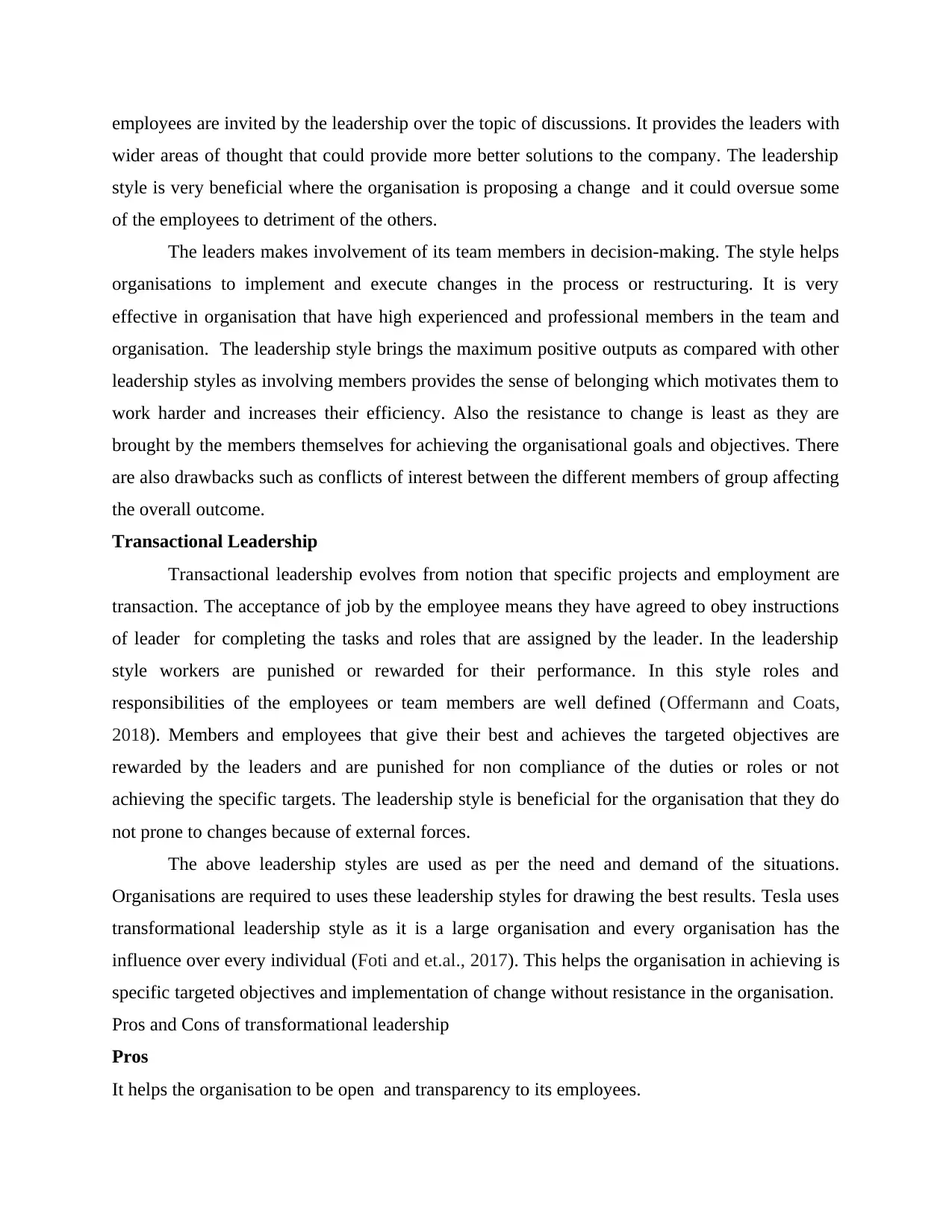
employees are invited by the leadership over the topic of discussions. It provides the leaders with
wider areas of thought that could provide more better solutions to the company. The leadership
style is very beneficial where the organisation is proposing a change and it could oversue some
of the employees to detriment of the others.
The leaders makes involvement of its team members in decision-making. The style helps
organisations to implement and execute changes in the process or restructuring. It is very
effective in organisation that have high experienced and professional members in the team and
organisation. The leadership style brings the maximum positive outputs as compared with other
leadership styles as involving members provides the sense of belonging which motivates them to
work harder and increases their efficiency. Also the resistance to change is least as they are
brought by the members themselves for achieving the organisational goals and objectives. There
are also drawbacks such as conflicts of interest between the different members of group affecting
the overall outcome.
Transactional Leadership
Transactional leadership evolves from notion that specific projects and employment are
transaction. The acceptance of job by the employee means they have agreed to obey instructions
of leader for completing the tasks and roles that are assigned by the leader. In the leadership
style workers are punished or rewarded for their performance. In this style roles and
responsibilities of the employees or team members are well defined (Offermann and Coats,
2018). Members and employees that give their best and achieves the targeted objectives are
rewarded by the leaders and are punished for non compliance of the duties or roles or not
achieving the specific targets. The leadership style is beneficial for the organisation that they do
not prone to changes because of external forces.
The above leadership styles are used as per the need and demand of the situations.
Organisations are required to uses these leadership styles for drawing the best results. Tesla uses
transformational leadership style as it is a large organisation and every organisation has the
influence over every individual (Foti and et.al., 2017). This helps the organisation in achieving is
specific targeted objectives and implementation of change without resistance in the organisation.
Pros and Cons of transformational leadership
Pros
It helps the organisation to be open and transparency to its employees.
wider areas of thought that could provide more better solutions to the company. The leadership
style is very beneficial where the organisation is proposing a change and it could oversue some
of the employees to detriment of the others.
The leaders makes involvement of its team members in decision-making. The style helps
organisations to implement and execute changes in the process or restructuring. It is very
effective in organisation that have high experienced and professional members in the team and
organisation. The leadership style brings the maximum positive outputs as compared with other
leadership styles as involving members provides the sense of belonging which motivates them to
work harder and increases their efficiency. Also the resistance to change is least as they are
brought by the members themselves for achieving the organisational goals and objectives. There
are also drawbacks such as conflicts of interest between the different members of group affecting
the overall outcome.
Transactional Leadership
Transactional leadership evolves from notion that specific projects and employment are
transaction. The acceptance of job by the employee means they have agreed to obey instructions
of leader for completing the tasks and roles that are assigned by the leader. In the leadership
style workers are punished or rewarded for their performance. In this style roles and
responsibilities of the employees or team members are well defined (Offermann and Coats,
2018). Members and employees that give their best and achieves the targeted objectives are
rewarded by the leaders and are punished for non compliance of the duties or roles or not
achieving the specific targets. The leadership style is beneficial for the organisation that they do
not prone to changes because of external forces.
The above leadership styles are used as per the need and demand of the situations.
Organisations are required to uses these leadership styles for drawing the best results. Tesla uses
transformational leadership style as it is a large organisation and every organisation has the
influence over every individual (Foti and et.al., 2017). This helps the organisation in achieving is
specific targeted objectives and implementation of change without resistance in the organisation.
Pros and Cons of transformational leadership
Pros
It helps the organisation to be open and transparency to its employees.
⊘ This is a preview!⊘
Do you want full access?
Subscribe today to unlock all pages.

Trusted by 1+ million students worldwide
1 out of 17
Related Documents
Your All-in-One AI-Powered Toolkit for Academic Success.
+13062052269
info@desklib.com
Available 24*7 on WhatsApp / Email
![[object Object]](/_next/static/media/star-bottom.7253800d.svg)
Unlock your academic potential
Copyright © 2020–2025 A2Z Services. All Rights Reserved. Developed and managed by ZUCOL.





